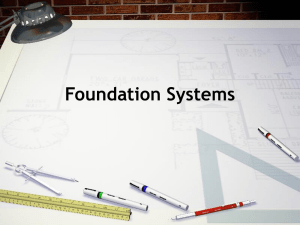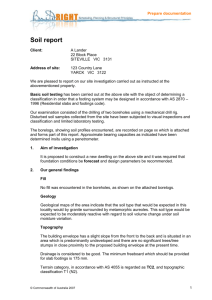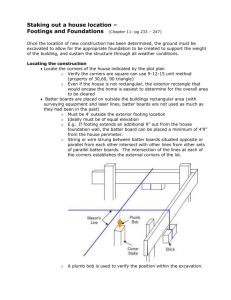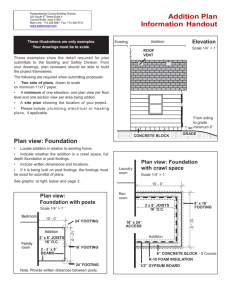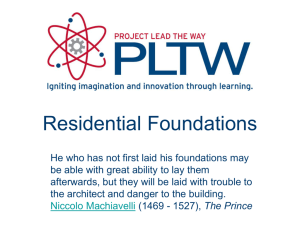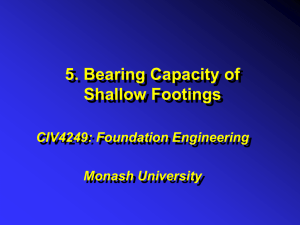Factors to Consider in Foundation Design Chapter # 02
advertisement
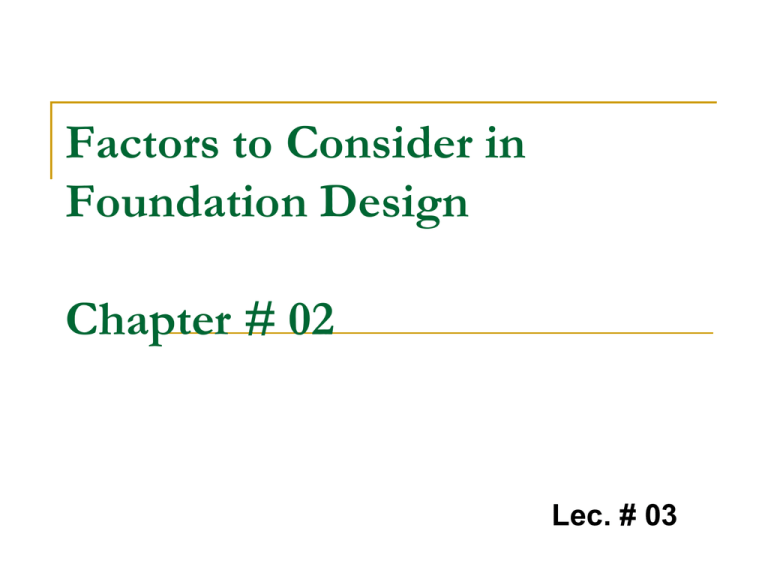
Factors to Consider in
Foundation Design
Chapter # 02
Lec. # 03
What are the key Factors?
1.
Effect of Frost Line
2.
Location consideration for Spread footings
3.
Net versus Gross Soil Pressure: (Design
soil pressures)
Erosion Problems for structures
adjacent to flowing water
Corrosion Protections
Water Table fluctuation
4.
5.
6.
1-Effect of Frost Line
Footing should be placed below or above
the frost line ?
It should be Placed below frost line.
Possible frost heave of the building and
because alternate freezing and thawing of the
soil tends to maintain it in an unconsolidated
or loose state
Frost or Permafrost conditions
Permafrost is a condition of permanently frozen
ground where the ground temperatures are never
higher than 00C. Construction in these areas
requires that the foundations be placed below this
material and into permafrost.
Where the soil is considered thaw-stable, the
foundation design is the same as in temperate
regions. Thaw stable soils are granular materials like
coarse sands and gravels. Pile foundations are
more reliable for permanent frost areas but are
much more expensive.
2-Location consideration for Spread footings
Case # 01
When footings are to be placed adjacent to
an existing structure, as indicated in figure
01, the line from the base of the new footing
to the bottom edge of the existing footing
should be 450 or less with the horizontal
plane.
From this requirement it follows that the
distance m of figure 01 should be greater
than the difference in elevation of the two
footings, zf.
Location consideration for Spread footings
Case # 02
If the new footing is lower than the existing footing
There is a possibility that the soil may flow latterly
from beneath the existing footing. This may increase
the amount of excavation somewhat but, more
important, may result in settlement cracks in the
existing building. This problem is difficult to analyze;
however an approximation of the safe depth zf may
be made for Φ–c using equation 01 & 02.
Since σ3= 0 on the vertical face of the
excavation. The critical pressure σ1 would
include the pressure from the existing footing.
σ1 ≈ γ zf + q0
---(01)
σ3= 0 = σ1 K- 2c √K
---(02)
= γ zf K+ q0 -2c √K
--- (03)
Solving for excavation depth zf (and using
Safety Factor), we obtained
Zf = {2c / [(SF) γ√K]} – {q0 / (SF) γ} -- (04)
3-Net versus Gross Soil Pressure
(Design soil pressures)
The bearing capacity equations are based on gross
soil pressure qult, which is everything above the
foundation level. If the allowable pressure is based
on the bearing capacity equations, the pressure is a
gross pressure.
Settlements are caused only by net increase in
pressure over the existing overburden pressure. If
the allowable pressure is based on settlement
consideration, it is a net pressure.
4-Erosion Problems for structures
adjacent to flowing water
Bridge piers, abutments, bases for retaining
walls and footings for other structures
adjacent to or located in flowing water must
be located at a depth such that erosion or
scour does not undercut the soil and cause a
failure
An accurate prediction of scour depth is
necessary so as to use the shortest possible
pile lengths
When Scouring Accelerated ?
Scour is accelerated if the foundation creates
channel obstruction;
To reduce scour the foundation should create
a minimum obstruction to normal stream flow
patterns
Approaches to avoid Scouring
Determine the foundation types
Estimate the probable depth of scour ,effects,
etc.
Estimate the cost of foundations for normal
and various scour conditions
Determine the cost versus risk and revise the
design accordingly
5-Corrosion Protections
In polluted ground areas such as old sanitary
landfills, shorelines, near sewer outfalls line from
older industrial plants, or backwater areas where
water stands over dead vegetation, there can be
corrosion problems with metal foundation
members as well as concrete. Concrete is
normally resistant to corrosion;
However, if sulfates are present, it may be
necessary to use sulfate-resistant concrete.
It may occasionally be necessary to use airentrained concrete for foundation members.
Use of treated timber piling instead of metal piling
may be required where the soil has a pH much
above 9.5 or below 4.0 (7 being neutral)
6-Water Table fluctuation
A lowered water table increases the effective
pressure and may cause additional
settlements. A raised water table may create
problems for the owner from the following;
Floating the structure ( making it unstable or
tilting it)
Reducing the effective pressure (causing
excessive settlement)
Creating a wet basement if the basement
walls are not watertight.
SOLUTION
By introducing some type of drainage (water does not
accumulate around the building walls or produce
hydrostatic uplift beneath the basement).
Use of drain tile around the basement perimeter
(common for residential dwellings and some larger
buildings).
A sloping basement excavation that is backfilled with
granular materials to the required horizontal level in
combination with a well (called a sump pit) at the low
point that is fitted with a pump (a sump pump system)
can be used.
Home work (For Snowy areas)
1: How does insulation stop frost heave from
occurring?
2: Does the soil type or ground cover (e.g., snow)
affect the amount of insulation required?
3: How long will the insulation protect the
foundation?
4: What happens if the heating system fails for a time
during the winter?
5: Why are greater amounts of insulation needed at
the corners of the foundation?
